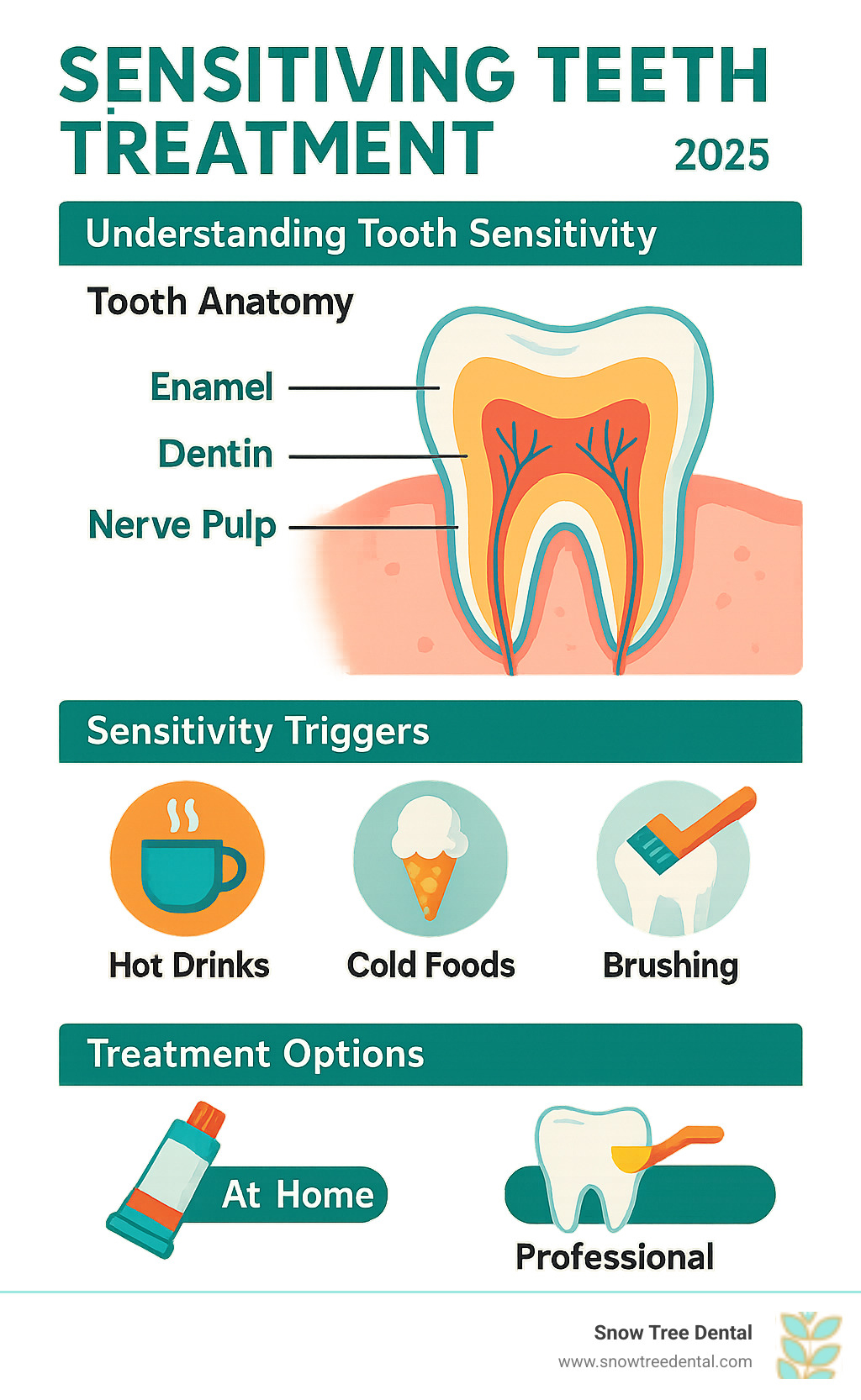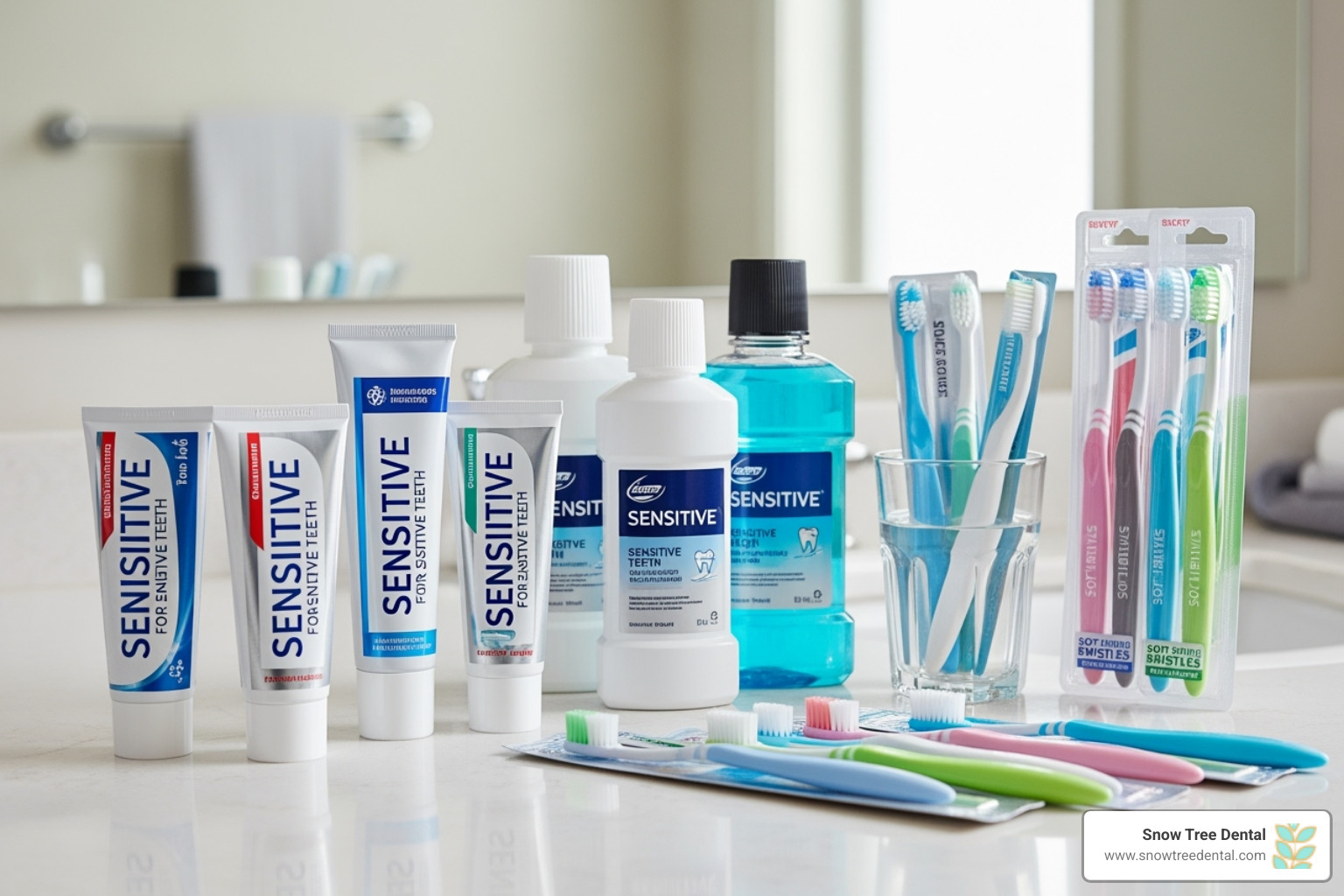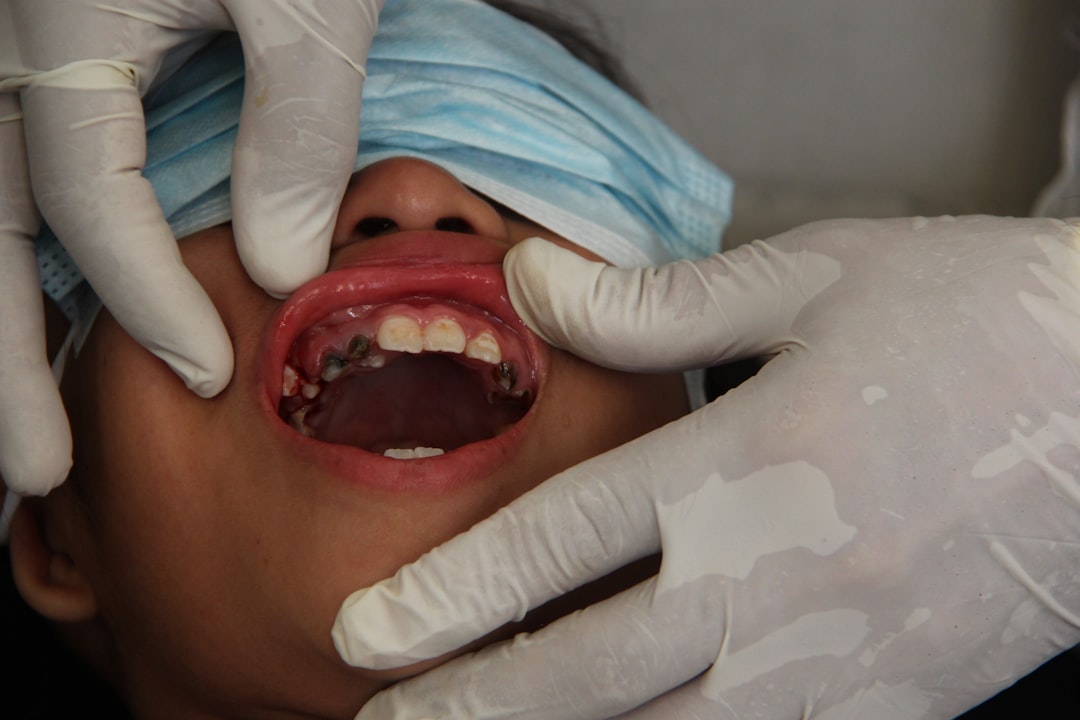Sensitive Teeth Treatment: #1 Pain Relief Guide
Understanding Tooth Sensitivity: A Common Yet Treatable Condition
Sensitive teeth treatment encompasses various approaches to address the sharp, temporary pain that affects one in eight dental patients according to a 2013 study. Here are the main treatment options:
At-Home Treatments:
- Desensitizing toothpaste with potassium nitrate or stannous fluoride
- Soft-bristled toothbrush with gentle brushing technique
- Fluoride mouthwash for enamel strengthening
- Saltwater rinses and natural remedies like clove gel
Professional Treatments:
- Fluoride varnish application every 2-3 months
- Dental bonding or sealants for exposed roots
- Gum grafts for severe gum recession
- Root canal therapy for underlying infections
Prevention Methods:
- Proper oral hygiene with gentle brushing
- Limiting acidic foods and drinks
- Using a straw for cold beverages
- Regular dental checkups
When you bite into ice cream or sip hot coffee, does a sharp pain shoot through your teeth? You’re not alone. Tooth sensitivity, medically known as dentin hypersensitivity, occurs when the protective enamel wears down or gums recede, exposing the softer dentin layer beneath. This dentin contains microscopic tubules that connect directly to your tooth’s nerve, creating that uncomfortable sensation when triggered by temperature changes, sweet foods, or even cold air.
The good news is that sensitive teeth are highly treatable. Whether through simple at-home care or professional dental procedures, relief is within reach. Most people find significant improvement with consistent use of desensitizing products, while others may need professional treatments like fluoride varnish or dental bonding.
I’m Dr. Muna Mohammad, and I’ve helped countless Houston families find effective sensitive teeth treatment solutions at Snow Tree Dental. My approach focuses on identifying the root cause of sensitivity and creating personalized treatment plans that fit each patient’s unique needs and lifestyle.

Understanding the Root Causes of Tooth Sensitivity
If you’ve ever winced from a sip of ice water, you’re experiencing your teeth’s way of telling you something important. Sensitive teeth treatment starts with understanding what’s happening beneath the surface of your smile.
Think of your teeth like a well-designed house. The shiny white enamel on top acts like a protective roof, while the roots are covered by a thinner layer called cementum. Underneath both of these protective layers lies something called dentin – and this is where the sensitivity story really begins.
Dentin is softer than enamel and filled with millions of tiny tubes called microscopic tubules. These little pathways connect directly to your tooth’s nerve center. When your protective enamel gets worn away or your gums pull back, these tubules become exposed. Suddenly, everything from hot coffee to cold air can travel straight to your nerve, creating that sharp, temporary pain we call tooth sensitivity.
Worn tooth enamel is one of the biggest culprits behind sensitive teeth. Your enamel can wear down from aggressive brushing – imagine scrubbing a delicate surface too hard with a rough sponge. Acidic foods and drinks like soda, citrus fruits, and even pickles can slowly erode this protective layer over time. It’s not that you need to avoid these foods completely, but understanding their impact helps you make smarter choices.
Gum recession is another major cause of sensitivity. When your gums pull away from your teeth, they expose the root surfaces that were never meant to face the outside world. A 2013 study on sensitivity and gum recession shows a clear connection between receding gums and tooth sensitivity. This can happen from brushing too hard, gum disease, or simply the natural aging process.
Do you grind your teeth at night or clench them during stressful moments? Teeth grinding (bruxism) puts enormous pressure on your teeth, gradually wearing down enamel and creating tiny cracks that expose the sensitive dentin underneath. Many people don’t even realize they’re doing it until their partner mentions the noise or they wake up with jaw pain.
Cracked teeth and worn fillings can also create pathways for sensitivity. Even hairline cracks that you can’t see can extend deep enough to reach the dentin. Old fillings may shrink, crack, or pull away from the tooth over time, leaving gaps where temperature and pressure can reach sensitive areas.
Sometimes sensitivity appears after recent dental procedures like cleanings, fillings, or crown placements. This temporary sensitivity usually fades within a few weeks as your tooth adjusts, but it’s always worth mentioning to your dentist if it persists or worsens.
Understanding these causes is the foundation of effective sensitive teeth treatment. At Snow Tree Dental, we believe prevention is always better than treatment, which is why we focus heavily on preventative dentistry to help you avoid sensitivity problems before they start.
Common Triggers for Tooth Pain
Once your dentin becomes exposed, certain everyday experiences can trigger that characteristic sharp pain. Hot foods and drinks like coffee, tea, or soup can cause the fluid inside those tiny tubules to expand, putting pressure on your nerve.
Cold foods and drinks work in the opposite way – they cause the fluid to contract, but the result is the same uncomfortable sensation. Ice cream, cold water, or even breathing in chilly winter air can trigger sensitivity.
Sweet or sour foods can penetrate the exposed tubules and directly irritate the nerve. This includes everything from candy and desserts to tangy fruits and acidic dressings.
Even routine oral care can become uncomfortable when you have sensitive teeth. Brushing or flossing might cause pain if your technique is too aggressive or if you’re using a hard-bristled brush on exposed dentin.
The good news? Once you understand what’s causing your sensitivity and what triggers it, you can take targeted steps to find relief and protect your teeth from further damage.
Your Guide to Sensitive Teeth Treatment

The moment you realize your teeth are sensitive doesn’t have to be the beginning of a lifelong battle with pain. Sensitive teeth treatment comes in many forms, from simple changes you can make at home to professional procedures that provide lasting relief. Think of it as having a toolkit – some problems need a gentle touch with basic tools, while others require the expertise of a professional.
At Snow Tree Dental, I’ve seen patients transform their daily lives by finding the right combination of treatments. Some find relief with a simple switch to desensitizing toothpaste, while others need a more comprehensive approach. The key is understanding your options and working with your dental team to create a plan that fits your specific needs.
At-Home Sensitive Teeth Treatment Options
Your bathroom cabinet might already hold the first line of defense against sensitive teeth. Desensitizing toothpaste is often where we start, and for good reason – it works. These specialized toothpastes contain active ingredients that tackle sensitivity in two different ways.
Potassium nitrate acts like a gentle sedative for your tooth nerves. It calms down those overactive nerve endings that are sending pain signals every time you sip something cold. Think of it as turning down the volume on your tooth’s alarm system.
Stannous fluoride takes a different approach by actually plugging up those microscopic tunnels in your dentin. It’s like filling tiny potholes in a road – once they’re sealed, the bumpy ride becomes smooth again.
The secret to success with desensitizing toothpaste is consistency. You need to use it twice daily for several weeks to see the full benefit. Some of my patients even apply a small dab directly to their most sensitive tooth before bed for extra relief.
Your toothbrush matters just as much as your toothpaste. A soft-bristled toothbrush paired with a gentle brushing technique can prevent further damage while you’re trying to heal existing sensitivity. Those vigorous back-and-forth scrubbing motions that feel so satisfying? They’re actually making things worse by wearing away more enamel and irritating your gums.
Fluoride mouthwash rounds out your at-home arsenal by strengthening your enamel and making it more resistant to future damage. It’s like adding an extra layer of armor to your teeth.
Here are the essential tips for brushing sensitive teeth without causing more harm:
- Use gentle, circular motions instead of aggressive scrubbing
- Brush for two minutes, twice daily with a soft-bristled brush
- Rinse with warm water since cold water can trigger sensitivity
- Apply minimal pressure – let the toothpaste do the work, not brute force
Natural Home Remedies to Soothe Discomfort
Sometimes the most effective solutions are hiding in your kitchen pantry. While these natural remedies aren’t replacements for professional care, they can provide welcome relief when sensitivity strikes.
A simple saltwater rinse is surprisingly powerful. Mix half a teaspoon of salt into a cup of warm water, swish it around for 30 seconds, and spit it out. Salt naturally reduces inflammation and acts as an antiseptic, giving your irritated tissues a chance to calm down.
Oil pulling might sound like something from a wellness blog, but there’s actual science behind this ancient practice. A 2015 pilot study on coconut oil pulling showed it could reduce plaque and improve gum health. Swish a tablespoon of coconut oil in your mouth for 10-15 minutes, then spit it out. Better gum health often means less sensitivity.
Clove gel has been dentistry’s secret weapon for centuries. The eugenol in cloves is a natural pain reliever that can provide immediate, though temporary, relief when applied directly to sensitive areas.
Guava leaves might surprise you, but these tropical leaves contain flavonoids with anti-inflammatory and pain-relieving properties. You can chew on a fresh leaf or make a rinse by boiling the leaves in water.
Turmeric paste brings the anti-inflammatory power of curcumin directly to your sensitive teeth. Mix turmeric powder with a little water to form a paste and apply it to the affected area for a few minutes.
Professional Sensitive Teeth Treatment at the Dentist
When home remedies aren’t enough, that’s when professional sensitive teeth treatment becomes your best friend. We have tools and techniques that can provide relief when nothing else works.

Fluoride varnish application is like giving your teeth a professional-strength shield. We paint this concentrated fluoride directly onto sensitive areas, where it forms a protective barrier and helps seal those open tubules. The role of fluoride in managing sensitivity is well-established, and many patients notice improvement within days. We typically recommend this treatment every few months for ongoing protection.
Dental bonding works beautifully when gum recession has exposed your tooth roots. We apply a tooth-colored resin material directly over the sensitive area, essentially giving your tooth a new protective coating. It’s both functional and cosmetic – you get pain relief and a more attractive smile.
Dentin sealants offer another way to block those troublesome tubules. This clear, protective coating acts like an invisible barrier between your sensitive dentin and the outside world.
For more severe cases, a gum graft might be necessary. This procedure involves taking healthy gum tissue and moving it to cover exposed root surfaces. It sounds more intimidating than it is, and the relief it provides can be life-changing for people with extensive gum recession.
Root canal therapy becomes necessary when sensitivity indicates that the tooth’s nerve is infected or severely inflamed. While nobody gets excited about a root canal, it’s often the only way to save a tooth and eliminate severe, persistent pain.
Our team handles everything from routine sensitivity treatments to complex procedures that restore both function and beauty to your smile. If you’re interested in learning about our full range of services, visit our cosmetic dentistry page to see how we can help you achieve your dream smile.
Prevention: Your First Line of Defense
Prevention is always better than cure, especially when it comes to tooth sensitivity. By adopting proactive care, mastering your oral hygiene, and making thoughtful dietary choices, you can significantly reduce your risk of developing sensitive teeth and maintain a comfortable, healthy smile.
Mastering Your Oral Hygiene Routine
Your daily brushing and flossing habits play a monumental role in preventing tooth sensitivity.
- Proper Brushing Technique: Avoid brushing too hard. Use a soft-bristled toothbrush and hold it at a 45-degree angle to your gumline, using gentle, short strokes. Think of it as massaging your teeth and gums, not scrubbing them. Brushing gently and using a soft-bristled electric toothbrush can be very effective.
- Flossing Daily: Flossing removes plaque and food particles from between your teeth and under the gumline, preventing gum disease and recession, which are major contributors to sensitivity. Clean all parts of your mouth, including between teeth and along the gumline.
- Using a Soft-Bristled Brush: As discussed, this is non-negotiable for preventing enamel wear and gum damage.
- Avoiding Abrasive Toothpaste: Some toothpastes, especially those marketed for “whitening” or “tartar control,” can be quite abrasive. Look for toothpastes with a low Relative Dentin Abrasivity (RDA) value, or simply stick to desensitizing toothpastes, which are typically less abrasive.
Lifestyle and Dietary Adjustments
What you eat and how you live can also impact your tooth sensitivity.
- Limiting Acidic Foods and Drinks: Acidic items like carbonated drinks, citrus fruits, tomatoes, and vinegars can erode tooth enamel. Try to reduce your intake of these, or consume them as part of a meal rather than sipping them throughout the day.
- Using a Straw: When drinking acidic beverages, using a straw can help bypass your teeth, limiting direct contact with enamel.
- Rinsing with Water After Acidic Meals: After consuming acidic foods or drinks, rinse your mouth with plain water. This helps neutralize the acids and wash away any lingering sugars, protecting your enamel.
- Calcium-Rich Diet: A diet rich in calcium, found in dairy products, leafy greens, and fortified foods, supports strong bones and teeth, including enamel. Chewing sugarless gum can also increase saliva production, which helps strengthen tooth enamel.
- Wearing a Mouthguard for Bruxism: If you grind or clench your teeth, especially at night, a custom-fitted mouthguard can protect your enamel from wear and prevent cracked teeth. We can help you with this solution right here in our Houston office.
Frequently Asked Questions about Tooth Sensitivity
As a dentist in Houston, I hear these questions about tooth sensitivity almost daily. Let me share some honest answers based on what I’ve seen work for my patients over the years.
How long does it take for desensitizing toothpaste to work?
Here’s the truth about desensitizing toothpaste – it’s not an overnight miracle, but it’s definitely worth the patience. Most of my patients start noticing some relief within a few days to two weeks of consistent use. The key word here is consistent. You need to use it twice daily, just like your regular toothpaste.
Think of it like starting a new exercise routine. You wouldn’t expect to see results after one trip to the gym, right? Your teeth need time to respond to the active ingredients, whether that’s potassium nitrate calming those nerve endings or stannous fluoride plugging up those tiny tubules in your dentin.
I always tell patients to give it at least four weeks of regular use before deciding it’s not working. And here’s a pro tip: some people find extra relief by dabbing a little directly on the sensitive spot before bed and leaving it there overnight.
Can tooth sensitivity go away on its own?
Sometimes yes, sometimes no – and that’s the honest answer. Temporary sensitivity after dental work like fillings or cleanings often resolves within a few weeks as your tooth settles down. It’s like your tooth is having a little tantrum after being worked on, but it usually calms down.
However, persistent sensitivity that’s been hanging around for weeks or months? That’s your tooth trying to tell you something important. It usually means there’s an underlying issue like worn enamel, gum recession, or even a small crack that won’t fix itself.
I’ve seen patients ignore sensitivity for months, hoping it would disappear, only to end up needing more extensive treatment later. The underlying causes – like exposed dentin or receding gums – typically get worse over time, not better. That’s why we offer comprehensive general dentistry services to catch these issues early.
When should I see a dentist for tooth sensitivity?
You know your mouth better than anyone, so trust your instincts. But here are some clear signals that it’s time to give us a call at Snow Tree Dental:
Persistent pain that doesn’t improve after several weeks of using desensitizing toothpaste is a red flag. If you’ve been diligent with your sensitive teeth treatment routine and still aren’t finding relief, we need to investigate further.
Severe discomfort that makes you wince or stops you mid-bite definitely warrants a visit. I’m talking about pain that’s sharp, intense, or lingers long after the trigger is gone. Life’s too short to suffer through every sip of coffee or bite of ice cream.
When sensitivity starts affecting your daily life, that’s when I know we need to step in. Are you avoiding your favorite foods? Drinking everything at room temperature? Dreading brushing your teeth? These aren’t compromises you should have to make.
Changes in gum color around sensitive teeth can signal infection or advanced gum disease. If your gums look darker, redder, or more swollen than usual, don’t wait.
Finally, sensitivity can be an early warning sign of a cavity or infection. What starts as minor discomfort can escalate to severe pain, abscesses, or tooth loss if left untreated. We’d much rather see you for a simple fluoride treatment than an emergency root canal six months later.
The good news? We make it easy to get the care you need with evening and Saturday appointments, plus same-day emergency slots when sensitivity suddenly becomes unbearable.
Conclusion: Take the Next Step Towards a Pain-Free Smile
If you’ve made it this far, you now understand that tooth sensitivity doesn’t have to be something you just “live with.” Whether your discomfort comes from worn enamel, exposed dentin, or gum recession, there are proven solutions that can bring you real relief.
The journey from pain to comfort often starts with simple changes. Maybe it’s switching to a desensitizing toothpaste with potassium nitrate, or trading your hard-bristled brush for a gentler option. For some patients, these at-home sensitive teeth treatment approaches provide all the relief they need.
But here’s what I’ve learned after years of treating sensitive teeth in Houston: the most important step is getting an accurate diagnosis. That sharp pain when you drink cold water might seem straightforward, but it could signal something more serious. A small cavity, a cracked filling, or advancing gum disease can all masquerade as simple sensitivity.
At Snow Tree Dental, we believe in getting to the root of the problem – literally. Our approach combines modern diagnostic technology with old-fashioned listening. We want to understand not just what hurts, but how it’s affecting your daily life. Are you avoiding your morning coffee? Skipping ice cream with the grandkids? These details help us create a sensitive teeth treatment plan that fits your specific needs.
What sets us apart is our commitment to making dental care accessible and comfortable. We offer flexible scheduling including evenings and Saturdays, transparent pricing so you know what to expect, and even an in-house dental plan to help manage costs. Whether you need a simple fluoride treatment or more comprehensive care, we’re here to help.
The truth is, you don’t have to let tooth sensitivity control what you eat and drink. With the right diagnosis and treatment plan, most patients find significant relief within weeks. Some see improvement in just days.
Ready to enjoy that ice cream cone again? Explore our comprehensive dental services and find how we can help you achieve the comfortable, healthy smile you deserve. Your pain-free future starts with a simple phone call.




